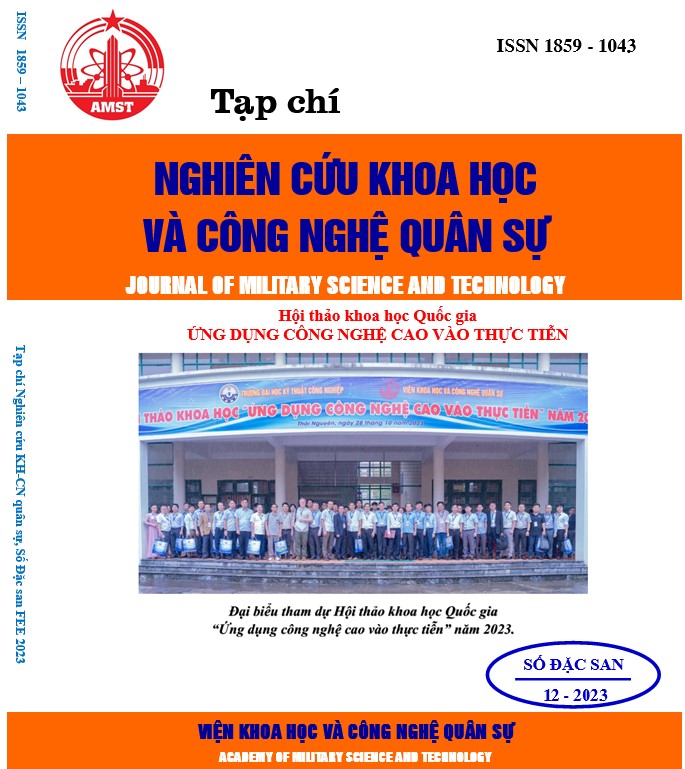Optimal controller FLC-Sugeno based on PSO for an active damping system
390 viewsDOI:
https://doi.org/10.54939/1859-1043.j.mst.FEE.2023.55-63Keywords:
FLC-Sugeno; Particle Swarm Optimization; Active suspension system; Quarter-vehicle models.Abstract
In this article, a method of designing an optimal fuzzy logic controller Sugeno model (FLC-Sugeno) control for active suspension system Quarter-vehicle models is presented. The parameters of FLC-Sugeno controller are considered a whole and optimally searched using the Particle Swarm Optimization algorithm (PSO). The 16 optimized parameters include: 03 parameters for adjusting the domain of the input state variables and control variables at the controller’s output, 04 fuzzy set adjustment numbers of the linguistic variables and 09 parameters, which are the fuzzy rule weights of the rule system control. To compare and evaluate the effectiveness of the optimal FLC-Sugeno controller, and optimal PID controller using PSO is also implemented. Simulation results of the active damping system with controllers when affected by the same type and standard road surface excitation show that FLC-Sugeno controller is optimal for the vehicle bodies displacement amplitude to be significantly and quickly end the oscillation cycles, establishing a stable balance. This result shows an extension when applying the design direction to more complex active damping system models.
References
[1]. Pekgökgöz, Recep Kadir, et al. “Active suspension of cars using fuzzy logic controller optimized by genetic algorithm.” International journal of engineering and applied sciences 2.4: 27-37, (2010).
[2]. Allam, Essam, et al. “Vibration control of active vehicle suspension system using fuzzy logic algorithm.” Fuzzy Information and Engineering 2.4: 361-387, (2010). DOI: https://doi.org/10.1007/s12543-010-0056-3
[3]. Changizi, Nemat, and Modjtaba Rouhani. “Comparing PID and fuzzy logic control a quarter car suspension system.” The journal of mathematics and computer science 2.3: 559-564, (2011). DOI: https://doi.org/10.22436/jmcs.02.03.18
[4]. Chen, Zhengke. “Research on fuzzy control of the vehicle’s semi-active suspension.” 2015 International Conference on Management, Education, Information and Control. Atlantis Press, (2015). DOI: https://doi.org/10.2991/meici-15.2015.111
[5]. Palanisamy, Senthilkumar, and Sivakumar Karuppan. “Fuzzy control of active suspension system.” Journal of Vibroengineering 18.5: 3197-3204, (2016). DOI: https://doi.org/10.21595/jve.2016.16699
[6]. Bhangal, Narinder Singh, and Kumar Amit Raj. “Fuzzy control of vehicle active suspension system.” International Journal of Mechanical Engineering and Robotics Research 5.2: 144, (2016). DOI: https://doi.org/10.18178/ijmerr.5.2.144-148
[7]. Basari, A. A., et al. “Fuzzy logic controller for half car active suspension system.” Journal of Telecommunication, Electronic and Computer Engineering (JTEC) 10.2: 125-129, (2018).
[8]. Han, Shi-Yuan, et al. “Adaptive fuzzy PID control strategy for vehicle active suspension based on road evaluation.” Electronics 11.6: 921, (2022). DOI: https://doi.org/10.3390/electronics11060921
[9]. Robert, J. Joshua, et al. “Fuzzy control of active suspension system based on quarter car model.” Materials Today: Proceedings 66: 902-908, (2022). DOI: https://doi.org/10.1016/j.matpr.2022.04.575
[10]. Yazid, N. E. H., et al. “New Fuzzy Logic Control for Quarter Vehicle Suspension System.” Artificial Intelligence and Heuristics for Smart Energy Efficiency in Smart Cities: Case Study: Tipasa, Algeria. Springer International Publishing, (2022). DOI: https://doi.org/10.1007/978-3-030-92038-8_64
[11]. T. A. Arslan et al. “Quarter Car Active Suspension System Control Using Fuzzy Controller”, Engineering Perspective 2 (4): 33-39, (2022). DOI: https://doi.org/10.29228/eng.pers.66798
[12]. Zhang, Zhenxing, and Jiuxiang Dong. “A new optimization control policy for fuzzy vehicle suspension systems under membership functions online learning.” IEEE Transactions on Systems, Man, and Cybernetics: Systems 53.5: 3255-3266, (2022). DOI: https://doi.org/10.1109/TSMC.2022.3224739
[13]. Takagi, Tomohiro, and Michio Sugeno. “Fuzzy identification of systems and its applications to modeling and control.” IEEE transactions on systems, man, and cybernetics 1: 116-132, (1985). DOI: https://doi.org/10.1109/TSMC.1985.6313399
[14]. Kennedy, James, and Russell Eberhart. “Particle swarm optimization.” Proceedings of ICNN'95-international conference on neural networks. Vol. 4. IEEE, (1995).
[15]. Koch, G.P.A.. “Adaptive Control of Mechatronic Vehicle Suspension”. PhD Thesis, Technical University of Munich, Munich, Germany, (2011).
[16]. Bryan Craig Murphy, “Design and contruction of a precision tubular linear motor and controller”, Submitted to the Office of Graduate Studies of Texas A&M University.







